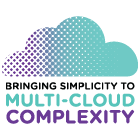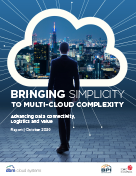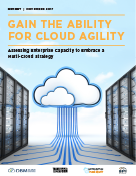Thought Leadership
Programs Background

Bringing Simplicity To Multi-Cloud Complexity
Advancing Data Connectivity, Logistics and Value
Overview
The Business Performance Innovation (BPI) Network, in partnership with DBM Cloud Systems and the CMO Council, is undertaking research into the forces, factors, challenges and requirements driving the need for improved data logistics in today’s multi-cloud world. Global enterprises are seeking to integrate vast repositories of data across multiple public and private clouds and on-premise systems to extract more value, use and return on these assets. In particular, this relates to decision-support analytics, product and service delivery, customer intelligence and personalized engagement, operational improvement, business compliance, and continuity.
While multi-cloud and hybrid cloud environments provide major advantages, they also increase the complexity of managing, translating, processing and moving data. Chief Data Officers, infrastructure IT executives and others in the enterprise are now seeking new and innovative ways to gain greater control, visibility, performance and efficiency in the way they manage data to optimize its value.
The program will engage data and IT executives from major companies, as well as leading system integrators, consulting firms and solution providers to understand needs, requirements and best practices in optimizing data economics, protection and logistics in today’s multi-cloud, mega-data world.
Background
The growing importance of the Chief Data Officer underscores widespread recognition of the essential role and value of data and analytics in the modern, agile customer-centric enterprise. This is further compounded by the significant cost, challenge and complexity of unifying, migrating, replicating, protecting, storing and governing data “ponds, lakes and dams” in today’s multi-cloud and hybrid cloud computing environments.
Data has become one of the chief engines of value creation. Its role in improving analytical decision making, enhancing our ability to understand, reach and engage customers, and increasing the value of both existing and new products and services has made data a highly valued currency and asset base for enterprises operating digitally across data borders, ramparts and fences.
Fueled by an explosive proliferation of new data sources—from mobile computing, social media and rich media applications and services, to the advent of the Internet of Things, which will generate some 50 million connected sensors by the end of 2020—the amount and variety of data being stored is growing exponentially. According Seagate Technology, the amount of data generated worldwide will increase to 163 zettabytes by 2025 from 12 zettabytes in 2015.
In today’s multi-cloud, mega-data world, better Data Logistics and Performance Management (DLPM) has become essential to competing in the Data Economy. According to 451 Research, some 80 percent of companies are now utilizing two or more clouds. Three-quarters of companies say they are pursuing a hybrid/multi-cloud strategy.
In this highly distributed compute environment, the requirements to understand where data resides across multiple public clouds and on-premise systems and cost-effectively store, protect and move data to its optimal location becomes critical. With the coming rise of edge computing and micro-data centers designed to bring data and applications closer to users to reduce latency and thereby improve application and workload performance, data management and logistics become even more complex. The edge is creating even more data, with increased data volumes having to be transmitted across networks and between clouds.
Object-based data storage is now the dominant storage architecture globally, particularly in the cloud, and will be used to store 85 percent of the world’s data by 2025. Developed initially to handle the explosive growth of unstructured data, such as video, images, web pages, log files and IoT data, object storage saves data along with associated metadata in blocks as objects that can contain multiple information formats.
It has a variety of advantages over file and block storage, including massive scalability, greater flexibility via metadata for analytics, better governance, faster retrieval, and improved cost efficiencies. In addition, continued technical advances are improving both the performance and the applicability of object storage for new use cases. A major challenge, however, is that the object-based storage systems used my various cloud providers are all different, making data synchronization and translation a challenge.
The Data Logistics Mandate
In this new world, Chief Data Officers and CIOs must optimize how they manage vast volumes of data across multiple clouds and data environments through better data logistics. There are more data silos, greater distribution of data, vast increases in volume, and a growing demand to understand, protect and exploit data for business growth and optimization while holding down costs.
Among those logistical challenges are the need to keep track of where data resides, and cost-effectively synchronize, replicate and move data to optimize value, efficiency, security and governance based on cost differences, processing and analytics capabilities, performance advantages, and regulatory requirements.
Organizations need to be able to be able to identify what data needs to be replicated and effectively transmitted and synchronized across different clouds and on-premise locations to improve the availability, security and value of data.
For example, organizations increasingly need to move data to specific service providers to conduct analytics or take advantage of specific vendor technologies, lower processing and storage costs, or meet geographic requirements. Particularly when data replication and synchronization is a continuous activity, organizations need to automate this process based on established rules and policies to improve cost efficiency, eliminate errors and reduce management complexity.
For object storage data, the capacity to fully utilize metadata to identify location, type and value is now a critical aspect of data logistics, as is the ability to transfer data with a minimum amount of performance degradation and data corruption. New solutions that can handle replication outside of the data path are delivering improved visibility, performance and data quality.
Advancing data logistics is a major imperative for today’s data-driven organizations and their chief data officers. The mandate to improve data availability, performance, value and cost-efficiency will be a critical competitive differentiator in a multi-cloud, mega-data world.
To get involved in this initiative, please reach out to Dave Murray.
Reports

Organizations worldwide are struggling to turn growing volumes of structured and unstructured data into readily available decision support for meaningful insights and actions.
Download »

This report explores a wide range of strategic business and technology issues in operationalizing multi-cloud to optimize agility, efficiency, security and control.
Download »

To elevate customer experience, the three critical functions as it relates to customer engagement: marketing, commerce and supply chain, must work together to elevate data strategies.
Download »

While enterprises around the world adopt a “cloud-first” technology strategy, significant challenges still stand in the way of realizing the full potential of the cloud. This study highlights both the huge advantages and significant obstacles they face.
Download »
Facts & Stats
Companies can typically reduce 30 percent of their data spending and 40 percent of their time to market for data products through next-generation use cases, including real-time demand estimations and pricing in e-commerce and advanced analytics models. (Source)
81 percent of public cloud users were working with two or more cloud providers before the pandemic. A multi-cloud approach allows users to take advantage of best-of-breed services and ensure better quality, resiliency and cost control during ordinary times, and during the Covid-19 crisis, the move toward hybrid multi-cloud architectures has dramatically accelerated. (Source)
53 percent of the IT professionals embrace hybrid and multi-cloud as their favorite form of deployment, consistent with actual deployment statistics which indicate hybrid cloud configurations constitute 42 percent of all cloud deployments. (Source)
Improving security across multiple clouds is by far the biggest concern identified by respondents as some 63 percent said that ensuring security across all clouds, networks, applications and data is one of their top challenges. (Source)
Almost two-thirds of technology and business leaders have already adopted a multi-cloud strategy and are using two or more public cloud platforms with the vast majority (84 percent) of respondents saying they will increase their use of public and private clouds over the next 24 months (Source)
Articles
August 10, 2020 - A Cornucopia Of Cloud Storage Solutions
Forbes
Read more »
July 22, 2020 - Hybrid Cloud Security: Benefits and Challenges
Business2Community
Read more »
July 22, 2020 - It’s Time To Rethink How To Get More From Your Data
Forbes
Read more »
July 21, 2020 - The power of emerging technologies: Finding value through data
Mckinsey Digital
Read more »
May 11, 2020 - How We're Getting Hybrid Cloud Wrong -- And Why It's Time To Course-Correct
Forbes
Read more »
Sponsor

DBM Cloud Systems believes that all companies should have a choice when it comes to managing the explosion of unstructured data in the Cloud. They focus on delivering Real-time Cloud Resource Brokering to lower Cloud spend, improve SLA's and efficiently manage data across all Cloud and on-premise repositories. Their team has extensive experience in deploying leading data management solutions – both on-premise and in the Cloud. They are storage and Cloud veterans with the technical and management expertise to partner with customers and deliver success.
Visit website »
Partner

The Chief Marketing Officer (CMO) Council is dedicated to high-level knowledge exchange,thought leadership and personal relationship building among senior corporate marketingleaders and brand decision-makers across a wide-range of global industries. The CMOCouncil’s 16,000+ members control more than $1 trillion in aggregated annual marketingexpenditures and run complex, distributed marketing and sales operations worldwide. Intotal, the CMO Council and its strategic interest communities include over 65,000 globalmarketing and sales executives in over 110 countries covering multiple industries, segmentsand markets. Regional chapters and advisory boards are active in the Americas, Europe,Asia Pacific, Middle East and Africa. The Council’s strategic interest groups include theCustomer Experience Board, Digital Marketing Performance Center, Brand InspirationCenter, Marketing Supply Chain Institute, GeoBranding Center, and the Coalition to Leverageand Optimize Sales Effectiveness (CLOSE). To learn more, visit www.cmocouncil.org.
Visit website »



 Share
Share